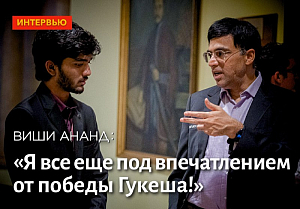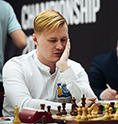The Viking Strategy
Dmitry Kryakvin reports about Russian Cup’s final battle of the open section in Khanty-Mansiysk
The final was doomed to go down into the chess history even before the game clock was set in motion. Not only is the age of the finalists put together younger than, for example, that of the older generation’s knight Sergey Volkov, knocked out earlier, the trophy will not stay in the Khanty-Mansiysk Autonomous Okrug for the first time in 3 years, but will leave for the western part of the country. A friend of mine, who has taken interest in the Cup only at the stage of semi-finals, claimed that Jakovenko's participation in the tournament would have left no chances to anyone. However, having delved into the history of previous rounds, he had to take his words back.
Both finalists have had other than rosy path to the final. David Paravyan has come through two tie-breaks, taking some rest in the quarter-finals (it is worth mentioning that one of his tie-breaks vs Tsydypov costs as many as three), while Kirill Alekseenko has played tie-breaks in every round, even if without Armageddons. Such an extensive number of games did not affect the match mood - the battle was more than combative! Thus, let us take a look at the middlegame of game one.
Alekseenko – Paravyan
Final, game one

Is it not a good start of the final match? The white king is under enemy’s fire, hoping to fend off the annoying black pieces and start pushing his dangerous a-pawn. As opposite to it, Black needs to squeeze as much as possible from the exposed situation of the white monarch. Whose cause will prevail?
36.exd5 Bg5+?!
This is a rare case of bringing all pieces into the game not working. White experiencing problems coordinating his army, a trade of some minor pieces is going to play into his hands. This said, good looking was 36...Bxd5 37.Kd3 Rc1 38.Be2 Be7 39.Rb2 Be6 40.a5 Bg5, giving hard time to the white king.
37.Kd3 Rd2+ 38.Kc3 Nf6 39.Nc7
With the white king in safety, the stage is set for the pawn to start its victorious march. Of course, Black still has a draw, but it now takes certain other than obvious measures, which is a challenge given a lack of thinking time.
39…Rd1 40.Bd3 Nxd5+
It stands to reason that David was apprehensive of the consequences of 40...Bd2+ 41.Kc2 Bxb4 42.Kxd1 Bb3+ 43.Bc2 as giving the a-pawn a free ride towards the queening square, but it is not clear how White is supposed to make any progress after 43…Bc4 44.a5 Nd7, as opposed to what happened in the game.
41.Nxd5 Bxd5 42.Rb1 Rd2 43.Rb2 Rd1 44.Be4

44…Bxe4?
A decisive mistake, although not an obvious one. The last chance was in 44...Rc1+! 45.Rc2 Rb1 (threatening a checkmate) 46.Bxd5 Rxb6, but even here 47.Ra2 gives White reasonable chances to bring the passed pawn all the way to the queening square. Now that the light-squared bishops are gone, Black can no longer keep the white passer at bay since the dark-squared bishop is denied any access to it and the rook is easily displaced from the a-file. Adamant in positions like this, Kirill made no exceptions this time around as well.
45.fxe4 Ra1 46.a5 f5 47.Re2 fxe4 48.Rxe4 Bc1 49.Kc2 Bf4 50.Kb2 Rd1 51.a6 Rd2+ 52.Kb3 Rd3+ 53.Kc4 Black resigns.
David needed to come back, which he did in his trademark style. He opened the game to a line that his opponent did not anticipate, outplaying him with simple moves and delivering a tactical blow when the time was right for it. It sounds easy enough, but Alekseenko, who has saved so many worse and much worse positions, had nothing to say to Paravyan’s pressure.
Paravyan – Alekseenko
Final, game two

Kirill’s last move was moving his knight from e8, leaving his king without defenders and to the care of fate. A piece sacrifice suggests itself, and David did not take long to come up with it - the bishop ruined the castled king's fortress in no time at all.
25.Bxg6! fxg6 26.Nxg6 Kh7
After 26...Kf7 27.Nf4 Qc7 White fails to get the rook and pawns vs two minor pieces balance, but he still has a very pleasant choice between continuing the offensive with 28.Nxh5 Ne8 29.e4 Bb7 30.Qh8, or appropriating the opponent’s pawns with 28.Qe5 Ne8 29.Qxh5+ Kg8 30.Nxd5 exd5 31.Rxd5, upon which White should have no problems bringing up four pawns edge home.
27.Ne7 Nf5 28.Nxc8 Rxc8 29.Qe5

29…Rg8
The engine offers giving back the appropriated via 29...Qc7 30.Qxc7+ Rxc7 31.e4 Ng3+ 32.Kh2 Nxe4, but there is little doubt in that Paravyan would have converted this exchange up surplus. Kirill managed to retain extra material and even tried to mount a sort of counterattack, but was checkmated.
30.e4 Ng3+ 31.Kh2 Bc6 32.Rd6 c4 33.Rxe6 Qe3 34.Re7+ Kh6 35.Qf6+, after 35…Rg6 White has a choice of winning continuations, and Kirill decided to throw the towel.
There is neither frightening nor amazing our main characters by tiebreaks, but the Russian Cup story writers are no such people! The last tie-break in the Cup finals dates back to 2009, when Evgeny Bareev managed to defeat Ian Nepomniachtchi, who was then gaining momentum, giving an interview afterwards in which he noted the opponent’s propensity to be confident in easy victories, which the young Nepomniachtchi took calmly and without any fighting back. Nowadays, Evgeny Ilgizovich has moved to Canada and is preparing to participate in Wijk aan Zee (albeit in tournament B), whereas Ian managed to assert himself in the national team and join the ranks of streamers, as well as playing in Wijk aan Zee (in tournament A). Alekseenko and Paravyan are writing another story as Khanty-Mansiysk has never seen a final tie-break yet. Meanwhile, a confrontation of peer players was very principled, but very correct as well.
It was not so long ago that Magnus Carlsen confirmed the effectiveness of the strategy demonstrated in the 2016 match against Sergey Karjakin. According to Carlsen, playing tie-breaks is a piece of cake as you just need to win the first game and play as sound chess as possible in the following encounters. Kirill Alekseenko managed to feel this strategy as deep as no one else on earth - the first three tiebreaks invariably began with the native of St. Petersburg’s winning, the fourth tie-break being no exception as well.
Paravyan – Alekseenko
Final, rapid game one

This time Kirill managed to equalize in a seemingly neutral setup arising after 1.d4 Nf6 2.c4 g6 3.Nf3 Bg7 4.e3, but winning the game takes a lot more drastic measures. Having given it some thought, Alekseenko makes up his mind to heat things up with the exchange sac.
18...Re5! 19.Ne4 Nxe4 20.Bxe5 Ng5 21.Bg3 Qh3+ 22.Kh1 h5
The time was melting down, and David started committing inaccuracies time and again.
23.f4?! Nh7 24.c5?!
David has merged two defensive ideas, which ultimately didn’t amount to anything good. If you move c4-c5, you should do it with the pawn on f3, so that Qc4 does the job of eyeballing the h-pawn; if the pawn is already on f4, there is no sense in sacrificing the c-pawn any longer. Without the sacrifice on c5, the same line could have appeared on the board, but without creating a dangerous passer for Black, which ultimately helped Black in taking the upper hand.
25.bxc5 25.f5
White could try to justify the pawn sacrifice via 25.b6 cxb6 26.f5 h4 27.Bxd6 Qf3+ 28.Kg1 h3 29.Kf1, but there will be very few volunteers going into this setup at a decisive moment of the match. David decides to give some material back, but Black's initiative won’t quell anyway.
25...h4 26.fxg6 Nf6 27.Rg1 hxg3 28.Rxg3 Qe6 29.Rcg1
There is no trading queens for White as it leads to reducing his saving chances drastically. With this in mind, good-looking was 29.Rg2! to try outfox the opponent in a position full of pieces, whereas the trade of queens renders the opponent's task easier by far.
29...Qe4+ 30.Qxe4 Nxe4 31.R3g2 fxg6 32.f4

White's last hopes are pinned to the play along the g-file, but it takes Kirill Alekseenko only three moves to entirely stop any traffic along this highway
32…g5! 33.h4 g4! 34.Kh2 g3+ 35.Kh3 c4
The g-line is now plugged, giving a free hand to set the passer in motion. Over a dozen and a half moves that followed Kirill was as cool as a Scandinavian Viking to end up scoring an important victory.
Knowing Alekseenko’s perfect awareness of the "Carlsen method", it was easy to predict the general trend of the second rapid game. David tried as best he could, even managing to put up some problems, but Kirill equalized and forced Paravyan into all or nothing situation.
Alekseenko – Paravyan
Final, rapid game two

David pinned his hopes on the bishop, but it was the one that ended up being pinned.
34.Rd5! Bxf4 35.Bxc5 Rbd8 36.Bb6 Rf8 37.g3, and because the bishop retreat involves a loss of yet another pawn, David opted for 37…Rg7, which did not secure him against going down in a short while. Thus, the Cup is heading for St. Petersburg!
David Paravyan followed his two bronze medals as part of team “Molodezhka” with a no less valuable award in this individual contest. Kirill Alekseenko’s winning the Cup seems subject to the “law of energy conservation” - even if failing to take the Chigorin Memorial for the fourth time in a row, the chances of winning main prize in a tournament reigned by another grandmaster are very high. I wonder if Kirill’s whole idea is to switch from one event to another so that now he intends to take the Russian Cup yet another time or two? I do not think Jakovenko and Kokarev will be happy to contribute to these plans, and the youth, as we have noticed by now, has been significantly gaining in strength with each subsequent event. It is a sure thing that the 2019 Russian Cup has something exciting in store for us in terms of final’s lineup!





















